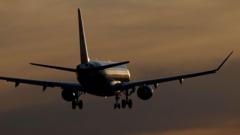Did a Delta Pilot Avoid Disaster with an Aggressive Maneuver Against a Military Aircraft?

Understanding the Recent Delta Airlines Incident: A Mid-Air Evasive Maneuver
The recent incident involving a Delta Airlines pilot raises important questions about air safety and the protocols in place to prevent mid-air collisions. A flight en route from Minneapolis to Minot, North Dakota, had to execute an "aggressive" evasive maneuver when a B-52 bomber was reported to be on a converging path. This event not only highlights the challenges pilots face in ensuring passenger safety but also the complexities of air traffic control. In this article, we will explore the details of the incident, the implications for aviation safety, and what passengers can learn from such experiences.
The Incident: What Happened?
On Friday, Delta Air Lines' regional jet, SkyWest Flight 3788, was navigating its final approach to Minot when the pilot detected a potential collision risk. As the pilot recounted, the military aircraft, identified as a B-52 bomber, was "kind of, sort of coming at us." This alarming statement, captured in video recordings shared on social media, immediately raises concerns about air traffic coordination and communication between civilian and military aircraft.
The quick thinking of the pilot allowed him to perform a sharp right turn, which resulted in a drastic change in the plane's orientation. According to passenger Monica Green, who recorded the incident, the maneuver was so severe that she found herself "facing the grass." Passengers expressed confusion and concern during the maneuver, unsure if the aircraft was in distress or if further evasive action would be necessary.
Post-Incident Explanation
After safely landing the aircraft, the pilot addressed the passengers, explaining that he had been instructed by air traffic control to make a right turn. Upon glancing at the B-52 bomber, he realized that it was on a converging course with their flight path, prompting him to maneuver away from it. The pilot noted the other aircraft was moving significantly faster than their regional jet, which necessitated a swift decision to avoid a potential collision.
The pilot's disclosure that he was caught off guard by the situation and had expected better communication from air traffic control underscores the importance of effective coordination in aviation. He concluded his statement with an apology, thanking the passengers for their understanding, which was met with applause—an indication of the passengers' relief and respect for the pilot's handling of a tense situation.
The Implications for Aviation Safety
Incidents like this highlight the critical need for robust safety measures in aviation. The fact that a civilian flight had to alter its course due to the proximity of a military aircraft raises important questions regarding airspace management and the protocols that govern it. Here are several key implications of this incident:
- Communication Protocols: Effective communication between military and civilian air traffic control is essential. Any lapses can lead to dangerous situations.
- Air Traffic Control Coordination: The incident emphasizes the need for seamless coordination between different branches of air traffic control to avoid similar occurrences in the future.
- Pilot Training and Preparedness: Pilots must be adequately trained to handle unexpected situations and make quick decisions to ensure passenger safety.
Air Traffic Control: A Closer Look
Air traffic control (ATC) is responsible for the safe and orderly flow of air traffic in the skies and on the ground. The ATC system consists of several components, including ground control, tower control, and en-route centers. Each plays a vital role in monitoring aircraft movements and ensuring that all flights maintain safe distances from one another.
In light of the recent incident, it is crucial to review how ATC coordinates with military flights. Military aircraft often operate under different protocols, which may not always align with civilian air traffic procedures. This discrepancy can lead to dangerous situations if not properly managed. Enhanced training programs for ATC personnel, focusing on military-civilian interaction, could be beneficial in preventing future incidents.
Passengers' Perspective: What to Expect
For passengers, the experience of an evasive maneuver can be frightening. It is essential for travelers to understand what actions to take in such situations. Here are several points to consider:
- Stay Calm: In the event of an unexpected maneuver, try to remain calm. The flight crew is trained for emergencies and will handle the situation.
- Listen to the Crew: Follow any instructions provided by the flight attendants or pilots. They are trained to ensure your safety.
- Be Prepared: Familiarize yourself with the safety procedures outlined in the safety briefing. Understanding where the exits are and how to use your seatbelt can be crucial.
Investigations and Future Measures
Following the incident, both SkyWest Airlines and the Federal Aviation Administration (FAA) have launched investigations. These investigations will examine the circumstances leading up to the evasive maneuver, including communication logs, air traffic control interactions, and the actions taken by both the pilot and the crew. The outcome of these investigations could lead to changes in protocols that may enhance safety in the skies.
Airlines may also implement additional training for pilots to prepare them for rare but potentially dangerous scenarios involving military aircraft. Furthermore, the FAA may review and refine regulations surrounding military airspace use to prevent similar incidents in the future.
Conclusion: Learning from Experience
While the incident involving SkyWest Flight 3788 was alarming, it serves as a critical reminder of the complexities involved in aviation safety. The quick actions of the pilot ensured the safety of all passengers onboard. As investigations unfold, it will be interesting to see what measures are taken to improve communication and coordination between civilian and military aviation operations.
As air travel continues to be a popular mode of transportation, staying informed about safety protocols and understanding the challenges faced by pilots is essential for passengers. This incident exemplifies the unpredictability of air travel and the importance of preparedness in the face of unexpected situations.
FAQs
What caused the Delta Airlines flight to perform an evasive maneuver?
The pilot detected a potential collision with a B-52 bomber and executed an evasive maneuver to avoid an accident.
How do pilots communicate with air traffic control during emergencies?
Pilots use radio communication to relay information to air traffic control and receive instructions on how to respond to various situations.
What should passengers do during an emergency maneuver?
Passengers should remain calm, listen to crew instructions, and be familiar with safety procedures outlined during the pre-flight briefing.
Are mid-air collisions common in commercial aviation?
Mid-air collisions are rare due to strict air traffic control protocols and technology designed to prevent such incidents.
As we reflect on this incident, it raises an important question: How can we enhance communication and collaboration between civilian and military aviation to ensure the safety of all air travelers? #AviationSafety #AirTrafficControl #DeltaAirlines
```Published: 2025-07-21 16:56:02 | Category: wales



